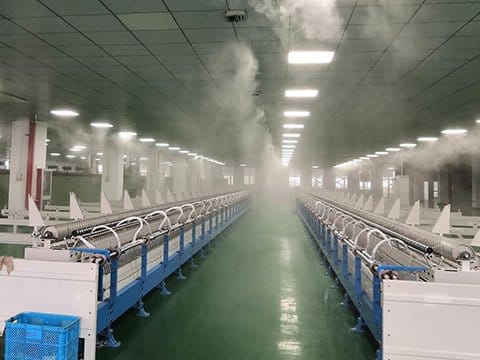Humidification for Printing Industry
Printing has very high requirements on the environment. During the printing process, both temperature, humidity and dust content will affect product quality. Changyuan Spray’s two-fluid dry mist humidifier uses atomization technology, which has fast humidification speed and simple and convenient operation. The intelligent control system can automatically humidify the air when it is dry based on the air humidity value you input, and stop working when the requirements are reached. It can stabilize the temperature and humidity of the production environment and is the best choice for printing factories.

Features:
- Prevent production efficiency from decreasing due to static electricity
- Fire prevention (static electricity countermeasures)
- Prevent paper moisture content from decreasing
Product Usage:
1. Eliminate static electricity
Printing is carried out on the surface of the object, and the electrostatic phenomenon is also mainly manifested on the surface of the object. The relationship between the two is very close. Due to the frequent impact, friction and contact between different substances during the printing process, almost all objects involved in the printing process are charged with static electricity. However, the impact of static electricity on the packaging and printing process has not received enough attention. Install dry mist humidifiers in the printing workshop to eliminate static electricity, improve production efficiency, improve product quality, reduce scrap rates and save energy.
2. Prevent paper from wrinkling, stretching and deformation
Humidification in printing plants is not only to prevent static electricity, but also has other functions. Taking offset printing as an example, especially in sheet-fed offset printing, changes in air humidity will directly cause the paper to absorb or lose water, causing paper deformation and affecting paper feeding during the printing process. With overprinting, the quality of printed products is reduced. In winter, when the air is dry, the paper will also lose a lot of moisture. Therefore, humidification at this time plays the role of humidifying the paper. Humidifying the paper can balance the moisture content of the paper and coordinate with the printing workshop. The temperature and humidity are adapted to improve the stability of the paper, thereby improving the overprinting accuracy and ensuring the printing quality.
3. Reduce dust and improve printing quality
To ensure that printing goes smoothly and product quality is guaranteed, in addition to the production process and skilled operators, the environment must also meet the printing requirements and prevent static dust from affecting printing. Then you can use Changyuan Spray's two-fluid dry mist humidifier. Increase the air humidity so that printing is not affected by drying.
System advantages:
- Controllable pressure setting, controllable coverage
- Gas power, two-stage atomization system;
- High-quality spray particles to avoid wetland occurrence;
- Optional temperature and humidity automatic control sensors can realize automatic humidification and cooling according to the actual air temperature and humidity;
- Installation is quick and easy, as long as the air compressor is connected, spraying can be done easily;
- Maintenance-free design, long service life and good spraying status can always be maintained.
System characteristics:
- Effectively prevent static electricity problems during installation, assembly and inspection.
- Prevent dirt and dust from adhering
- Use dry mist humidification to save energy and prevent electrostatic damage to semiconductor components.
- Compared with other humidification methods, the humidifier has the significant advantages of being maintenance-free, no dripping, low energy consumption, fine atomization particles, high atomization energy efficiency, and fast humidification speed.
- It has multiple uses such as air humidification, purification, anti-static, cooling, and dust reduction.
Atomization principle:
It works on the latest vacuum siphon principle to generate ultra-fine mist of a two-stage atomization system. The spray particle diameter is 5-7.5μm. It looks more like smoke than mist, and as soon as it comes out of the nozzle, it dissolves in the air and turns into humidity. In addition, because the dry mist is very fine, even if it touches something, it will not be adsorbed or repelled. Therefore, it is also called “non-wetting mist”.
Through the mixing of two fluids, air and water, and three gasification and shearing effects, the sonic air ejected from the nozzle is again atomized, and the aerosol that is also atomized from the other nozzle collides with each other and is repeatedly sheared. , generates sound waves of 33,000-40,000 Hz to make the droplets more granular, and the equalization atomization principle achieves multi-stage atomization to obtain good spray effects.
